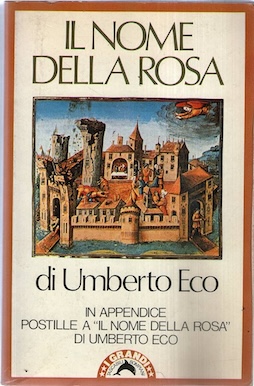
di Umberto Eco
L’opera, ambientata sul finire dell’anno 1327, si presenta con un classico espediente letterario, quello del manoscritto ritrovato, opera, in questo caso, di un monaco di nome Adso da Melk, che, divenuto ormai anziano, decide di mettere su carta i fatti notevoli vissuti da novizio, molti decenni addietro, in compagnia del proprio maestro Guglielmo da Baskerville. La vicenda si svolge all’interno di un monastero benedettino ed è suddivisa in sette giornate, scandite dai ritmi della vita monastica.
Guglielmo (rancescano e inquisitore “pentito”) è stato inviato al monastero dall’imperatore con lo scopo di partecipare ad un congresso che vedrà protagonisti i francescani (sostenitori delle tesi pauperistiche e alleati dell’imperatore Ludovico) e i delegati della curia papale di Papa Giovanni XXII, insediata a quei tempi ad Avignone.
L’abate però ,nel timore che un recente “suicidio” possa turbare tale evento,incarica Guglielmo (e Adso di conseguenza) di indagare. Nel corso dei giorni però accadono altre tragedie ed una serie di indizi porteranno il francescano alla verità ,senza però evitare tragiche conseguenze al monastero stesso.
Questo romanzo è stato anche trasposto in video grazie ad un film ((The Name of the Rose) del 1986 diretto da Jean-Jacques Annaud dove Guglielmo e Adso sono interpretati rispettivamente da Sean Connery e Christian Slater.
English Version
The work, set at the end of the year 1327, presents itself with a classic literary device, that of the found manuscript, authored in this case by a monk named Adso of Melk, who, now aged, decides to put on paper the remarkable events he experienced as a novice many decades earlier in the company of his master William of Baskerville. The story takes place within a Benedictine monastery and is divided into seven days, marked by the rhythms of monastic life.
William (a Franciscan and a “repentant” inquisitor) has been sent to the monastery by the emperor with the purpose of participating in a congress that will feature the Franciscans (supporters of poverty doctrines and allies of Emperor Louis) and the delegates of the papal curia of Pope John XXII, who at that time was based in Avignon.
However, the abbot, fearing that a recent “suicide” might disturb the event, tasks William (and consequently Adso) with investigating. Over the days, other tragedies occur, and a series of clues will lead the Franciscan to the truth, though not without tragic consequences for the monastery itself.
This novel was also adapted into a film (The Name of the Rose) in 1986, directed by Jean-Jacques Annaud, where William and Adso are portrayed by Sean Connery and Christian Slater, respectively.